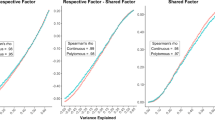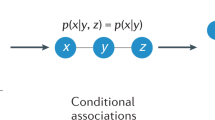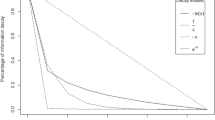Abstract
We introduce the network model as a formal psychometric model, conceptualizing the covariance between psychometric indicators as resulting from pairwise interactions between observable variables in a network structure. This contrasts with standard psychometric models, in which the covariance between test items arises from the influence of one or more common latent variables. Here, we present two generalizations of the network model that encompass latent variable structures, establishing network modeling as parts of the more general framework of structural equation modeling (SEM). In the first generalization, we model the covariance structure of latent variables as a network. We term this framework latent network modeling (LNM) and show that, with LNM, a unique structure of conditional independence relationships between latent variables can be obtained in an explorative manner. In the second generalization, the residual variance–covariance structure of indicators is modeled as a network. We term this generalization residual network modeling (RNM) and show that, within this framework, identifiable models can be obtained in which local independence is structurally violated. These generalizations allow for a general modeling framework that can be used to fit, and compare, SEM models, network models, and the RNM and LNM generalizations. This methodology has been implemented in the free-to-use software package lvnet, which contains confirmatory model testing as well as two exploratory search algorithms: stepwise search algorithms for low-dimensional datasets and penalized maximum likelihood estimation for larger datasets. We show in simulation studies that these search algorithms perform adequately in identifying the structure of the relevant residual or latent networks. We further demonstrate the utility of these generalizations in an empirical example on a personality inventory dataset.










Similar content being viewed by others
Notes
Throughout this paper, vectors will be represented with lowercase boldfaced letters and matrices will be denoted by capital boldfaced letters. Roman letters will be used to denote observed variables and parameters (such as the number of nodes), and Greek letters will be used to denote latent variables and parameters that need to be estimated. The subscript i will be used to denote the realized response vector of subject i, and omission of this subscript will be used to denote the response of a random subject.
We make use here of the convenient all-y notation and do not distinguish between exogenous and endogenous latent variables (Hayduk, 1987).
A saturated GGM is also called a partial correlation network because it contains the sample partial correlation coefficients as edge weights.
To our knowledge, the GGM has not yet been framed in this form. We chose this form because it allows for clear modeling and interpretation of the network parameters.
We use the CFA framework instead of the SEM framework here as the main application of this framework is in exploratively estimating relationships between latent variables.
Developmental version: http://www.github.com/sachaepskamp/lvnet; stable version: https://cran.r-project.org/package=lvnet.
References
Arbuckle, J. L. (1996). Full information estimation in the presence of incomplete data. In G. A. Marcoulides & R. E. Schumacker (Eds.), Advanced structural equation modeling (pp. 243–277). Mahwah, NJ: Lawrence Erlbaum Associates, Inc.
Benet-Martinez, V., & John, O. (1998). Los Cinco Grandes across cultures and ethnic groups: Multitrait multimethod analyses of the big five in Spanish and English. Journal of Personality and Social Psychology, 75, 729–750.
Bentler, P. M. (1990). Comparative fit indexes in structural models. Psychological Bulletin, 107(2), 238–346.
Borsboom, D. (2008). Psychometric perspectives on diagnostic systems. Journal of Clinical Psychology, 64(9), 1089–1108.
Borsboom, D., & Cramer, A. O. J. (2013). Network analysis: An integrative approach to the structure of psychopathology. Annual Review of Clinical Psychology, 9, 91–121.
Borsboom, D., Cramer, A. O. J., Schmittmann, V. D., Epskamp, S., & Waldorp, L. J. (2011). The small world of psychopathology. PloS ONE, 6(11), e27407.
Browne, M. W., & Cudeck, R. (1992). Alternative ways of assessing model fit. Sociological Methods & Research, 21(2), 230–258.
Chandrasekaran, V., Parrilo, P. A., & Willsky, A. S. (2012). Latent variable graphical model selection via convex optimization (with discussion). The Annals of Statistics, 40(4), 1935–1967.
Chen, J., & Chen, Z. (2008). Extended Bayesian information criteria for model selection with large model spaces. Biometrika, 95(3), 759–771.
Costantini, G., Epskamp, S., Borsboom, D., Perugini, M., Mõttus, R., Waldorp, L. J., et al. (2015). State of the aRt personality research: A tutorial on network analysis of personality data in R. Journal of Research in Personality, 54, 13–29.
Cramer, A. O. J., Sluis, S., Noordhof, A., Wichers, M., Geschwind, N., Aggen, S. H., et al. (2012). Dimensions of normal personality as networks in search of equilibrium: You can’t like parties if you don’t like people. European Journal of Personality, 26(4), 414–431.
Cramer, A. O. J., Waldorp, L., van der Maas, H., & Borsboom, D. (2010). Comorbidity: A network perspective. Behavioral and Brain Sciences, 33(2–3), 137–150.
Dalege, J., Borsboom, D., van Harreveld, F., van den Berg, H., Conner, M., & van der Maas, H. L. J. (2016). Toward a formalized account of attitudes: The causal attitude network (CAN) model. Psychological Review, 123(1), 2–22.
Dempster, A. P. (1972). Covariance selection. Biometrics, 28(1), 157–175.
Digman, J. (1989). Five robust trait dimensions: Development, stability, and utility. Journal of Personality, 57(2), 195–214.
Dziak, J. J., Coffman, D. L., Lanza, S. T., & Li, R. (2012). Sensitivity and specificity of information criteria. The Methodology Center and Department of Statistics: Penn State, The Pennsylvania State University.
Ellis, J. L., & Junker, B. W. (1997). Tail-measurability in monotone latent variable models. Psychometrika, 62(4), 495–523.
Epskamp, S., Maris, G., Waldorp, L., & Borsboom, D. (in press). Network psychometrics. In Irwing, P., Hughes, D., and Booth, T., (Eds.), Handbook of psychometrics. Wiley, New York, NY.
Epskamp, S., Waldorp, L. J., Mõttus, R., & Borsboom, D. (2016). Discovering psychological dynamics in time-series data. arXiv preprintarXiv:1609.04156.
Foygel, R., & Drton, M. (2010). Extended Bayesian information criteria for Gaussian graphical models. Advances in Neural Information Processing Systems, 23, 2020–2028.
Fried, E. I., Bockting, C., Arjadi, R., Borsboom, D., Amshoff, M., Cramer, O. J., et al. (2015). From loss to loneliness: The relationship between bereavement and depressive symptoms. Journal of Abnormal Psychology, 124(2), 256–265.
Fried, E. I., & van Borkulo, C. (2016). Mental disorders as networks of problems: A review of recent insights.
Gates, K. M., & Molenaar, P. C. (2012). Group search algorithm recovers effective connectivity maps for individuals in homogeneous and heterogeneous samples. NeuroImage, 63(1), 310–319.
Goldberg, L. (1993). The structure of phenotypic personality traits. American Psychologist, 48(1), 26–34.
Goldberg, L. R. (1990). An alternative “description of personality”: The big-five factor structure. Journal of Personality and Social Psychology, 59(6), 1216–1229.
Hayduk, L. A. (1987). Structural equation modeling with LISREL: Essentials and advances. Baltimore, MD: Johns Hopkins University Press.
Hoerl, A. E., & Kennard, R. W. (1970). Ridge regression: Biased estimation for nonorthogonal problems. Technometrics, 12(1), 55–67.
Holland, P. W., & Rosenbaum, P. R. (1986). Conditional association and unidimensionality in monotone latent variable models. The Annals of Statistics, 14, 1523–1543.
Ising, E. (1925). Beitrag zur theorie des ferromagnetismus. Zeitschrift für Physik A Hadrons and Nuclei, 31(1), 253–258.
Isvoranu, A. M., Borsboom, D., van Os, J., & Guloksuz, S. (2016a). A network approach to environmental impact in psychotic disorders: Brief theoretical framework. Schizophrenia Bulletin, 42(4), 870–873.
Isvoranu, A. M., van Borkulo, C. D., Boyette, L. L., Wigman, J. T., Vinkers, C. H., Borsboom, D., & Group Investigators. (2017). A network approach to psychosis: Pathways between childhood trauma and psychotic symptoms. Schizophrenia bulletin, 43(1), 187–196.
Jacobucci, R., Grimm, K. J., & McArdle, J. J. (2016). Regularized structural equation modeling. Structural Equation Modeling: A Multidisciplinary Journal, 23(4), 555–566.
Jöreskog, K. G. (1967). A general approach to confirmatory maximum likelihood factor analysis. ETS Research Bulletin Series, 1967(2), 183–202.
Kaplan, D. (2000). Structural equation modeling: Foundations and extensions. Thousand Oaks, CA: Sage.
Kolaczyk, E. D. (2009). Statistical analysis of network data. New York, NY: Springer.
Koller, D., & Friedman, N. (2009). Probabilistic graphical models: Principles and techniques. Cambridge, MA: MIT Press.
Kossakowski, J. J., Epskamp, S., Kieffer, J. M., van Borkulo, C. D., Rhemtulla, M., & Borsboom, D. (2015). The application of a network approach to health-related quality of life (HRQoL): Introducing a new method for assessing hrqol in healthy adults and cancer patient. Quality of Life Research, 25, 781–792.
Lauritzen, S. L. (1996). Graphical models. Oxford: Clarendon Press.
Lawley, D. N. (1940). VI.—the estimation of factor loadings by the method of maximum likelihood. Proceedings of the Royal Society of Edinburgh, 60(01), 64–82.
Lord, F. M., Novick, M. R., & Birnbaum, A. (1968). Statistical theories of mental test scores. Oxford: Addison-Wesley.
MacCallum, R. C., Wegener, D. T., Uchino, B. N., & Fabrigar, L. R. (1993). The problem of equivalent models in applications of covariance structure analysis. Psychological Bulletin, 114(1), 185–199.
Marsh, H. W., Morin, A. J., Parker, P. D., & Kaur, G. (2014). Exploratory structural equation modeling: An integration of the best features of exploratory and confirmatory factor analysis. Annual Review of Clinical Psychology, 10, 85–110.
Marsman, M., Maris, G., Bechger, T., & Glas, C. (2015). Bayesian inference for low-rank ising networks. Scientific reports, 5(9050), 1–7.
McCrae, R. R., & Costa, P. T. (1997). Personality trait structure as a human universal. American Psychologist, 52(5), 509–516.
McGill, R., Tukey, J. W., & Larsen, W. A. (1978). Variations of box plots. The American Statistician, 32(1), 12–16.
McNally, R. J., Robinaugh, D. J., Wu, G. W., Wang, L., Deserno, M. K., & Borsboom, D. (2015). Mental disorders as causal systems a network approach to posttraumatic stress disorder. Clinical Psychological Science, 3(6), 836–849.
Murphy, K. P. (2012). Machine learning: A probabilistic perspective. Cambridge, MA: MIT press.
Neale, M. C., Hunter, M. D., Pritikin, J. N., Zahery, M., Brick, T. R., Kirkpatrick, R. M., et al. (2016). Openmx 2.0: Extended structural equation and statistical modeling. Psychometrika, 81(2), 535–549.
Pan, J., Ip, E., & Dube, L. (in press). An alternative to post-hoc model modification in confirmatory factor analysis: The bayesian lasso. Psychological Methods.
Pearl, J. (2000). Causality: Models, reasoning, and inference. New York, NY: Cambridge University Press.
Reckase, M. D. (2009). Multidimensional item response theory. New York, NY: Springer.
Revelle, W. (2010). psych: Procedures for Psychological, Psychometric, and Personality Research (R package version 1.0-93). Northwestern University, Evanston, IL.
Rosa, M., Friston, K., & Penny, W. (2012). Post-hoc selection of dynamic causal models. Journal of Neuroscience Methods, 208(1), 66–78.
Schmittmann, V. D., Cramer, A. O. J., Waldorp, L. J., Epskamp, S., Kievit, R. A., & Borsboom, D. (2013). Deconstructing the construct: A network perspective on psychological phenomena. New Ideas in Psychology, 31(1), 43–53.
Tibshirani, R. (1996). Regression shrinkage and selection via the lasso. Journal of the Royal Statistical Society Series B (Methodological), 58, 267–288.
van Borkulo, C. D., Borsboom, D., Epskamp, S., Blanken, T. F., Boschloo, L., Schoevers, R. A., et al. (2014). A new method for constructing networks from binary data. Scientific Reports, 4(5918), 1–10.
van Borkulo, C. D., Boschloo, L., Borsboom, D., Penninx, B. W. J. H., Waldorp, L. J., & Schoevers, R. A. (2015). Association of symptom network structure with the course of depression. JAMA Psychiatry, 72(12), 1219–1226.
van der Maas, H. L., Dolan, C. V., Grasman, R. P., Wicherts, J. M., Huizenga, H. M., & Raijmakers, M. E. (2006). A dynamical model of general intelligence: The positive manifold of intelligence by mutualism. Psychological Review, 113(4), 842–861.
Ware, J. E, Jr., & Sherbourne, C. D. (1992). The MOS 36-item short-form health survey (SF-36): I. Conceptual framework and item selection. Medical Care, 30, 473–483.
Wright, S. (1921). Correlation and causation. Journal of Agricultural Research, 20(7), 557–585.
Wright, S. (1934). The method of path coefficients. The Annals of Mathematical Statistics, 5(3), 161–215.
Yin, J., & Li, H. (2011). A sparse conditional gaussian graphical model for analysis of genetical genomics data. The Annals of Applied Statistics, 5(4), 2630–2650.
Zou, H., & Hastie, T. (2005). Regularization and variable selection via the elastic net. Journal of the Royal Statistical Society: Series B (Statistical Methodology), 67(2), 301–320.
Zou, H., Hastie, T., Tibshirani, R., et al. (2007). On the degrees of freedom of the lasso. The Annals of Statistics, 35(5), 2173–2192.
Author information
Authors and Affiliations
Corresponding author
Electronic supplementary material
Below is the link to the electronic supplementary material.
Rights and permissions
About this article
Cite this article
Epskamp, S., Rhemtulla, M. & Borsboom, D. Generalized Network Psychometrics: Combining Network and Latent Variable Models. Psychometrika 82, 904–927 (2017). https://doi.org/10.1007/s11336-017-9557-x
Received:
Revised:
Published:
Issue Date:
DOI: https://doi.org/10.1007/s11336-017-9557-x




